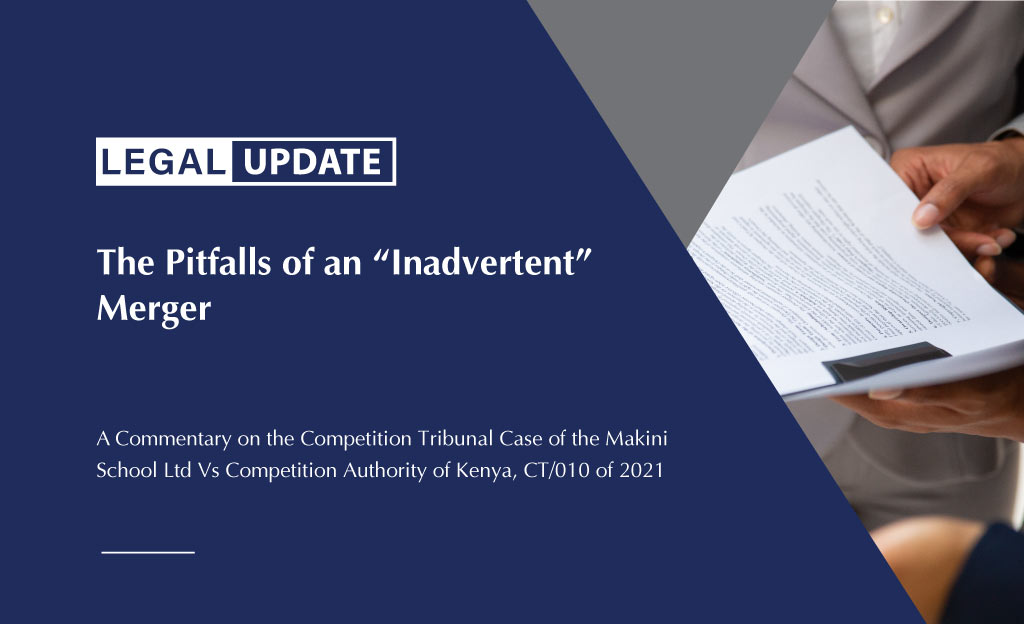A COMMENTARY ON THE COMPETITION TRIBUNAL CASE OF THE MAKINI SCHOOL LTD VS COMPETITION AUTHORITY OF KENYA, CT/010 OF 2021.
By Frankline Michael Otieno & Ogolla Omondi Elvis
- INTRODUCTION
- An omission on a merger approval application has cost the Makini School Limited a hefty financial penalty of Kshs. 7,238,876. The penalty was imposed by the Competition Authority of Kenya (CAK) in accordance to Section 42 (6) of the Competition Act No. 12 of 2010 (“hereinafter referred to as the Act).
- In reference to the case in point, it is imperative for merging/acquiring undertakings to subject their proposed processes to the strict tenets of the Act, the regulations thereto, the Capital Markets Authority regulations on mergers (for listed companies), while also keeping in mind the regional East African Community and COMESA laws concerning mergers to avoid legal battles and resultant penalties that would have otherwise been avoided had the undertakings been wary enough.
- FACTS
- The Appellant herein, being an educational institution, was on an expansion move. The Appellant became aware of an existing school complex, R.K. Bhayani Nursery and Primary School (“the School”). The school complex was run as a sole proprietorship but whose sole proprietor had died sometime in 2017. The executors of the proprietor’s estate sought to wind up the school. Moreover, the land on which the school complex was situated was leased from the Trustees of Shree Lohana Mahajan-Kisumu (“the Lessor”). The Lessor issued a six (6) months’ vacation notice to the school.
- It is not clear on when the appellant became aware of the availability of the school complex. However, prompted by the vacation/termination notice, the Appellant entered into a lease with the Lessor effective 1st April 2019. The school went ahead and terminated the services of its employees. Thereafter, the appellant issued a circular to the students of the then defunct R.K. Bhayani Nursery and Primary School welcoming them to Makini and even outlined the “seamless” transition process from Bhayani to Makini School. A total of 242 pupils and 11 staff members of the defunct school were absorbed into the Appellant’s school.
- The Respondent herein, the CAK, sought an explanation from the Appellant on the status of the school before the appellant took possession of the complex, the chronology of events leading to the appellant opening a campus in the school, the premises configuration, and the lease arrangement of the premises.
- After correspondences, meetings and consideration of the information and documentations provided, the Respondent concluded that the applicant took up an operation school as they signed the lease in 2019 but has already entered the school complex in 2018, therefore the lease in favor of Bhayani was still alive when the appellant entered the school complex. The effect of this was that the business of Bhayani was effectively transferred to the appellant. Secondly, the respondent found that the appellant had offered pupils of the Bhayani admission to the appellant’s school at the same fee the students had been paying at Bhayani and final years students and their teachers were accommodated by the appellant. Moreover, eleven members of staff of Bhayani were taken up by the appellant. Lastly and in essence, the old school had since been rebranded to Makini School. The Respondent proceeded to make a declaration and slap the appellant with a financial penalty, which was initially set at Kshs. 36,199,380.95 but later reduced to Kshs. 7,239,876 after mitigation by the Appellant.
- Ostensibly, the Appellant was unhappy with CAK’s decision, prompting it to lodge an Appeal to the Competition Tribunal, pursuant to section 73 of the Act.
- APPELLANT’S CASE
- The crux of the Appellant’s argument was that it did not acquire the former Bhayani school but only leased the premises of the former Bhayani School and accommodated some of its students and teachers. It also argued that Bhayani was not in existence at the time of the claimed acquisition. The Appellant urged that since Bhayani was operated as a sole proprietorship, the death of its proprietor essentially meant that the school automatically ceased to exist since the school was indistinguishable from its dead proprietor. Furthermore, the executors of its deceased proprietor were in the process of winding up the school.
- The Appellant also argued that it did not acquire the lease from Bhayani but from the Lessor. The only asset acquired in the transaction was the complex, which was also owned by the lessor as it was on the property it had leased. The Appellant contended that it had only made a proposal to the Lessor to enter into a new lease in April 2019 after Bhayani had vacated the premises.
- The Appellant contended that that taking former students and some of the staff members was purely a corporate social responsibility venture, and that at any rate, it gained no financial benefit from integrating the existing Bhayani students into the Appellant
- It is noteworthy that the Appellant advanced a novel argument that the students and staff members of Bhayani school did not in any event constitute “assets” within the meaning of Section 2 of the Act. Since they were natural persons, they were incapable of being owned by another person, or being a legal interest capable of acquisition, sale or transfer. Moreover, the members of staff and children would have opted to independently choose other institution to teach and learn.
- Most importantly, the Appellant argued that there was no exchange of purchase price or consideration in the alleged acquisition as required under Section 42 (2) of the Act denoting the existence of a merger after payment of at least 20% of the purchase price. Therefore, in the absence of consideration, there could be no merger.
- RESPONDENTS’ CASE
- The Respondent was adamant that that there existed a merger/acquisition between the Appellant and the school, Bhayani as per section 2 of the Act.
- The Respondent argued that the merger was evidenced by the fact that Bhayani was operational undertaking at all material times. The Respondent further relied on the definition of the undertaking as being a business intended to be carried on, or carried on for gain or reward by a person, a partnership or a trust in the production, supply or distribution of goods or provision of any service, and includes a trade association.
- The Respondents argued that an undertaking is an entity engaged in an economic activity regardless of its form or the way it is financed. Moreover, the death of the proprietor of Bhayani did not result in the automatic cessation of existence of the school’s operations. At the time of its acquisition, Bhayani was still operational with students, teachers and other staff.
- Moreover, the chain of events towards the appellant taking over the premises and setting up the school, business at the school complex, taking up the staff members and the pupils of Bhayani to its establishment signified the fact that there was an acquisition/merger between Bhayani and Appellant.
- The Respondent also contended that the Appellant in fact acquired control of the business of Bhayani school as the transfer of business was affected by the transfer of students, teachers and support staff.
- The Respondent buttressed the fact that the acquisition was an asset from which revenue can be generated and one that affects strategic competitive impact of the business. In this regard, the students and members of staff were therefore business assets from which revenue could be generated. Interestingly, the Respondent’s argument was that teachers and students are central to a school business as buildings without teachers and students are not a school business.
- Since the Appellant confirmed that some of the teaching staff were retained from Bhayani. Accordingly, the Respondent relied on the European Commission’s Notice on the concept of a concentration under Council Regulation (ECC) No. 4064/89 on the control of concentrations between undertakings, a partial acquisition qualifies as an acquisition. Additionally, the acquiring of a revenue generating asset may translate to the acquisition of the business.
- ISSUES FOR DETERMINATION
- The Tribunal framed the following issues for determination:
- Whether there was a merger between Bhayani and the Appellant?
- Whether proof of payment is prerequisite for proof of implementation of merger?
- Whether the appellant was mandated to inform the Respondent of the transaction?
- RATIO DECIDENDI
- On the existence of the merger
- On Whether there was a merger between Bhayani and the Appellant, the Tribunal relied on the definition of a merger and an undertaking under section 2 of the Act. To that end, the Tribunal opined that at the time of taking over the School Complex by the Appellant, the school was still operational. Further, the administrator continued to operate the school as a business even after the proprietor’s death. This according to the Tribunal, was evidenced by the fact that despite the fact that there was a notice issued to Bhayani to vacate the premises by September 2018, the school had issued a school fees structure of up to the year 2019. The Tribunal found that the school complex was still operational and indeed the appellant took over the complex as of 2019.
- To buttress the existence of a merger, the tribunal took the view that teachers and pupils at Bhayani constituted assets as per the definition of section 2 of the Act and therefore, capable of being acquired. The Tribunal’s reasoning was that customers are the ultimate assets for any profit-making organization. In this case, students are the ultimate customers in a school and remain the most critical revenue stream.
- In making this finding, the Tribunal relied on the case of Societe Cooperative de Production SeaFrance SA (Respondents) v The Competition and Markets Authority and another (Appellants) where the court stated:
“…in others, such as skilled service industries, key staff may constitute an enterprise…the commission considered that the enterprise of SeaFrance was constituted essentially by the combination of the vessels, the employees and to a limited extent the brand and goodwill. It approached the acquisition of these three classes of assets….”
- As to whether the Appellant’s execution of the lease over the premises where Bhayani school existed, the Tribunal found that mere execution of Alease over premises is not an acquisition of business assets within the purview of the Act. The Tribunal indeed confirmed that as per the case of Netto/Grocery Store at Armitage Avenue Little Hulton, the transfer of a freehold property of a single real estate asset does not constitute a merger.
- However, despite the above finding, the Tribunal still found that there was a merger on account of the Appellant’s acquisition of the former students and staff of Bhayani. Therefore, the students and teachers constituted an enterprise, which changed hands from the Target entity (Bhayani) to the Appellant.
- On whether proof of payment/Consideration is a mandatory prerequisite for implementation of merger
- On this issue, the Appellant had argued that it was not demonstrated that the Appellant paid consideration in respect of the transaction. Therefore, according to the Appellant, in the absence of proof of consideration, there could be no merger.
- However, the Tribunal took the view that a reading of sections 2 and 41(2)(a) of the Act, payment was not a prerequisite for the occurrence of a merger.
- Put differently, once the parameters outlined under section 41 (2) (a) and (b) of the Act are satisfied, then a merger materializes. The tribunal’s understanding of section 42 (4) was that the payment of at least 20% of the purchase price in a merger transaction would constitute implementation of a merger even where the outcomes contemplated under section 2 of and section 41 (2) are intended but yet to materialize.
- The tribunal found the appellant in breach of the Act and proceeded to dismiss the appeal.
- IMPLICATIONS OF THE DECISION
- Firstly, this case establishes that the existence of a merger can be inferred from the totality of the events taking place between two entities, even where the parties did not intend a merger. Therefore, in case there is a dispute as to the existence of the merger, the particular transactions in question shall be mirrored against the definition of a merger and the tenets set out under section 41 (2) (a) and (b) of the Act to arrive at a conclusive answer. In other words, and strictly speaking, it is neither the definition nor the intention of the parties that determines a merger or acquisition but the facts surrounding that particular transaction.
- Secondly, most importantly, the Tribunal has clarified that natural persons are capable of being classified as assets in a merger/acquisition transaction especially if they are the ‘engines’ behind an undertaking’s turnover, directly as a source of revenue. In quoting a case that supports this position, the Appellant had indeed acquired the income generating element of Bhayani, and coupled with other supporting facts in the transaction, successfully led to the existence of a merger. Therefore, the argument that people are not assets capable of acquisition, sale or transfer cannot be a valid argument for disputing the existence of a merger.
- Thirdly, where undertakings in a transaction are in doubt as to the nature of their dealings, it is advisable for them to seek legal advice on the same and an authorization from the Authority on the nature of the transaction and whether an approval is needed.
- Lastly is that payment of consideration is not a mandatory requirement for the existence of a merger, as such, a merger can exist whether or not consideration has been paid. Therefore, provided the undertakings have satisfied the fundamentals under Section 41 (2) (a) and (b) of the Act, then a merger exists.
This article is provided free of charge for information purposes only; it does not constitute legal advice and should be relied on as such. No responsibility for the accuracy and/or correctness of the information and commentary as set in the article should be held without seeking specific legal advice on the subject matter. If you have any query regarding the same, please do not hesitate to contact Litigation Department at Litigation@wamaeallen.com
 Loading...
Loading...
About the author
Frankline M. Otieno is a dispute resolution associate, recommended professional and committed to offering sustainable client-centred solutions to legal issues.
Frankline is astute in commercial litigation, securities law, banking law, intellectual property litigation, public procurement, land law litigation, Judicial Review and Administrative law litigation, sports law, tax litigation, administrative law, consumer protection law, competition law and constitutional litigation.
Ogolla Omondi Elvis is an Associate in the Commercial, Conveyancing & Real EstateDepartment and specialises in banking & finance law, securitization, general property law,
company and corporate law, legal compliance, joint ventures, business formations and general commercial transactions.
He has a wealth of expansive experience, knowledge and essential comprehension of the legal frameworks relating to the property and commercial sector in Kenya.
Elvis has been involved in providing corporate and commercial advice to clients in a wide range of sectors.
Elvis further has an experience with fintech in their particular spaces.












